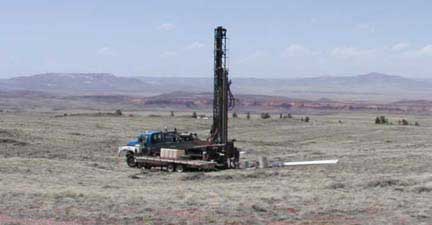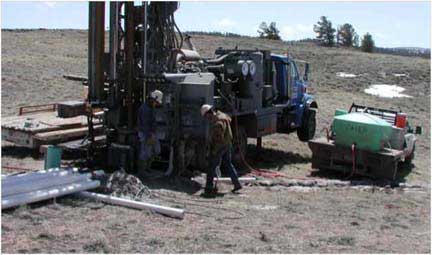 |
 |
| Home | Blogs | Solargon | More Links | Workshops | Innovation |
We obtained a well permit from the State of Colorado in spring 2009, and engaged a well contractor. We learned in hindsight how NOT to do a well. A main mistake was to drill during the spring snowmelt – so much meltwater was making its way down past the steel casing in the well bore that it was hard to tell if and when we hit any other water. The result was that we have a 600 foot deep well in which the static water level is just 20 feet below the surface. At least water is assured!
 This is the drill rig at work at the designated place at our site - although there is no snow in this image, about a foot of it had just melted and the meltwater was draining through the ground and into the wellbore. This made it difficult to tell if we had hit any new water sources as we drilled. You can see, in this picture and the one below, the white PVC casing that is installed below the level of the steel casing. The PVC casing is perforated so that water can get into it from the raw wellbore.
This is the drill rig at work at the designated place at our site - although there is no snow in this image, about a foot of it had just melted and the meltwater was draining through the ground and into the wellbore. This made it difficult to tell if we had hit any new water sources as we drilled. You can see, in this picture and the one below, the white PVC casing that is installed below the level of the steel casing. The PVC casing is perforated so that water can get into it from the raw wellbore.

This view of the drilling rig and crew shows a last bit of snow in the process of quickly metling. The well ended up 600 feet deep - we simply weren't sure if we had hit any water sources. We had an indication of an increase in flow past around 500 feet, but nothing we hit really stood out as "hey, we've hit a fracture and suddenly there's increased flow!" So - hope for the best but be prepared for what you will do if in fact the result is unclear and uncertain! Your well may "well" go way over budget - but it's one of those things that's pretty much necessary unless you want to haul water!
Click here to continue to a page on well completion, pump installation, and providing solar power to the pump.

